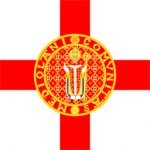- Location
- The Place Beyond The Pines
- Pronouns
- he/him
1837-1845 Former Senator William Henry Harrison of Ohio (Whig)
1836 (with Representative Francis Granger of New York) def. President Martin Van Buren of New York (Democratic)
1840 (with Vice President Francis Granger of New York) def. Former Governor Lewis Cass of Michigan (Democratic)
1845-1849 Senator James Buchanan of Pennsylvania (Democratic)
1844 (with Representative Richard M. Johnson of Kentucky) def. former Senator Henry Clay of Kentucky (Whig)
1849-1857 General Winfield Scott of New York (Whig)
1848 (with Former Senator Thomas Ewing of Ohio) def. President James Buchanan of Pennsylvania (Democratic)
1852 (with Vice President Thomas Ewing of Ohio) def. Senator Stephen A. Douglas of Illinois (Democratic)
1857-1861 Senator Charles Sumner of Massachusetts (Whig)
1856 (with Senator John Bell of Tennessee) def. Senator James A. Bayard Jr. of Delaware (Democratic)
1861-1865 Governor Graham N. Fitch of Indiana (Democratic)
1860 (with President pro tempore of the Senate Benjamin Fitzpatrick) def. President Charles Sumner of Massachusetts (Whig), Vice President John Bell of Tennessee (Constitutionalist)
1865-1869 Senator William H. Seward of New York (Whig)
1864 (with Former State Representative Cassius M. Clay of Kentucky) def. Senator Jefferson Davis of Mississippi (Democratic), Senator Milton Latham of California (Constitutionalist), President Graham N. Fitch of Indiana (Northern Democratic)
1865: Beginning of the Conventional Phase of the Southron War
1868: Southron Government Surrenders, Beginning of the Southron Insurrection
1869-1877: Vice President Cassius M. Clay of Kentucky (Union)
1868 (with Former Secretary of the Interior George Bancroft of Massachusetts) def. General Robert E. Lee of Virginia (Independent endorsed by Constitutionalist)
1872 (with Vice President George Bancroft of Massachusetts) def. Former Senator Waitman T. Willey of Virginia (Constitutionalist)
1877: Former Senator Lyman Trumbull of Massachusetts* (Union)
1876 (with Former Governor William Tweed of New York) def. Former State Representative John Martin of Pawnee (Constitutionalist)
1877: Lyman Trumbull Removed from Office for Treason
1877-1893: Vice President William Tweed of New York (Union)
(Vacant)
1879: Southron Insurrection Ends
1880 (with Financier Charles Yerkes of Illinois) def. Lawyer Charles J. Guiteau of Illinois (Constitutionalist),Activist August Faulkner of Ohio (Free Labor)
1884 (with Vice President Charles Yerkes of Illinois) def. Scattered Opposition
1888 (with Vice President Charles Yerkes of Illinois) def. Scattered Opposition
1893-1911: Major General Nelson A. Miles of Massachusetts (Union)
1892 (with Publisher John R. McLean of Ohio) def.Senator John Kyle of Dakota (People's), Senator Donald Cameron of Pennsylvania ('True' Union)
1896 (with Vice President John R. McLean of Ohio) def. Philanthropist Seymour F. Norton of Illinois (Agrarian People's), Former Governor John P. Buchanan of Tennessee (Free People's)
1900 (with Representative Raymond Corral of Arizona) def. Senator Anselm J. McLaurin of Mississippi (Southron), Mayor T.J. Roosevelt of New York (Independent), Representative James Watson of Indiana (Agrarian People's), Farmer Davis Ward of Georgia (Free People's)
1904 (with Vice President Raymond Corral of Arizona) def. Governor George Jennings of Florida (Southron), Representative Thomas Tibbles of Platte (People's), Publisher George Hearst Jr. of Pennsylvania (Freedom)
1908 (with Senator John Bryan of Platte) def.Representative Joseph Cannon (People's Leading Anti-Reelectionist Pact - Southron-Freedom-People's)
1909: American Civil War Begins
1836 (with Representative Francis Granger of New York) def. President Martin Van Buren of New York (Democratic)
1840 (with Vice President Francis Granger of New York) def. Former Governor Lewis Cass of Michigan (Democratic)
1845-1849 Senator James Buchanan of Pennsylvania (Democratic)
1844 (with Representative Richard M. Johnson of Kentucky) def. former Senator Henry Clay of Kentucky (Whig)
1849-1857 General Winfield Scott of New York (Whig)
1848 (with Former Senator Thomas Ewing of Ohio) def. President James Buchanan of Pennsylvania (Democratic)
1852 (with Vice President Thomas Ewing of Ohio) def. Senator Stephen A. Douglas of Illinois (Democratic)
1857-1861 Senator Charles Sumner of Massachusetts (Whig)
1856 (with Senator John Bell of Tennessee) def. Senator James A. Bayard Jr. of Delaware (Democratic)
1861-1865 Governor Graham N. Fitch of Indiana (Democratic)
1860 (with President pro tempore of the Senate Benjamin Fitzpatrick) def. President Charles Sumner of Massachusetts (Whig), Vice President John Bell of Tennessee (Constitutionalist)
1865-1869 Senator William H. Seward of New York (Whig)
1864 (with Former State Representative Cassius M. Clay of Kentucky) def. Senator Jefferson Davis of Mississippi (Democratic), Senator Milton Latham of California (Constitutionalist), President Graham N. Fitch of Indiana (Northern Democratic)
1865: Beginning of the Conventional Phase of the Southron War
1868: Southron Government Surrenders, Beginning of the Southron Insurrection
1869-1877: Vice President Cassius M. Clay of Kentucky (Union)
1868 (with Former Secretary of the Interior George Bancroft of Massachusetts) def. General Robert E. Lee of Virginia (Independent endorsed by Constitutionalist)
1872 (with Vice President George Bancroft of Massachusetts) def. Former Senator Waitman T. Willey of Virginia (Constitutionalist)
1877: Former Senator Lyman Trumbull of Massachusetts* (Union)
1876 (with Former Governor William Tweed of New York) def. Former State Representative John Martin of Pawnee (Constitutionalist)
1877: Lyman Trumbull Removed from Office for Treason
1877-1893: Vice President William Tweed of New York (Union)
(Vacant)
1879: Southron Insurrection Ends
1880 (with Financier Charles Yerkes of Illinois) def. Lawyer Charles J. Guiteau of Illinois (Constitutionalist),
1884 (with Vice President Charles Yerkes of Illinois) def. Scattered Opposition
1888 (with Vice President Charles Yerkes of Illinois) def. Scattered Opposition
1893-1911: Major General Nelson A. Miles of Massachusetts (Union)
1892 (with Publisher John R. McLean of Ohio) def.
1896 (with Vice President John R. McLean of Ohio) def. Philanthropist Seymour F. Norton of Illinois (Agrarian People's), Former Governor John P. Buchanan of Tennessee (Free People's)
1900 (with Representative Raymond Corral of Arizona) def. Senator Anselm J. McLaurin of Mississippi (Southron), Mayor T.J. Roosevelt of New York (Independent), Representative James Watson of Indiana (Agrarian People's), Farmer Davis Ward of Georgia (Free People's)
1904 (with Vice President Raymond Corral of Arizona) def. Governor George Jennings of Florida (Southron), Representative Thomas Tibbles of Platte (People's), Publisher George Hearst Jr. of Pennsylvania (Freedom)
1908 (with Senator John Bryan of Platte) def.
1909: American Civil War Begins













